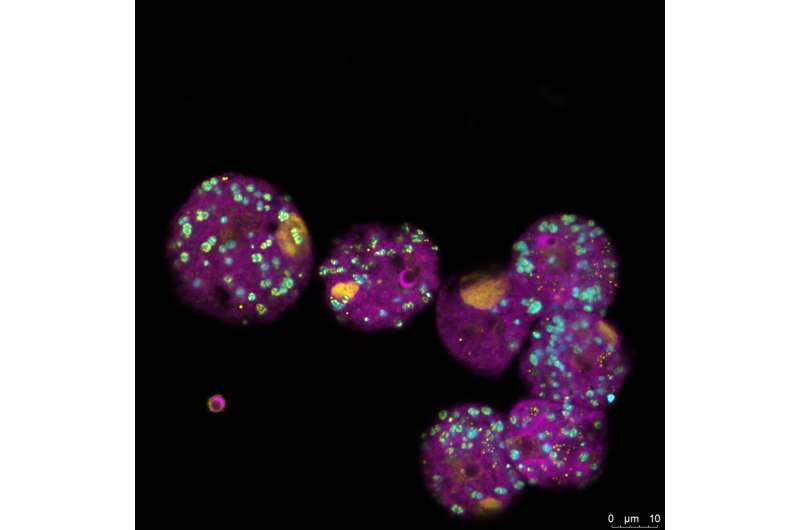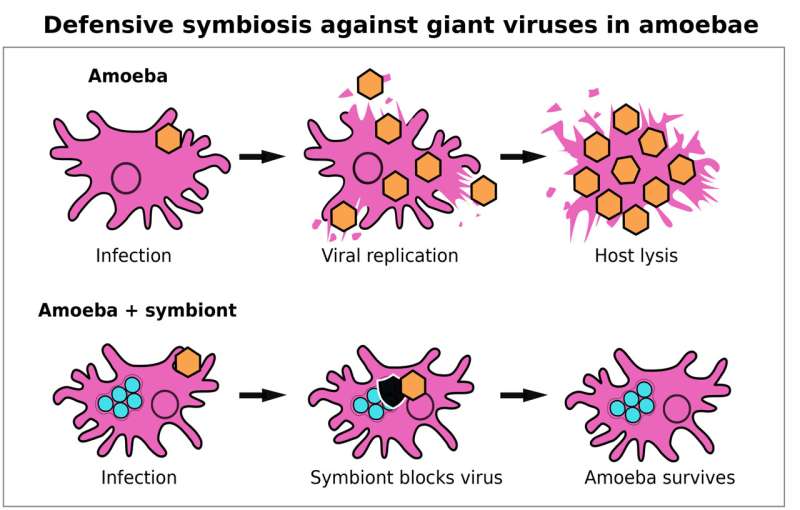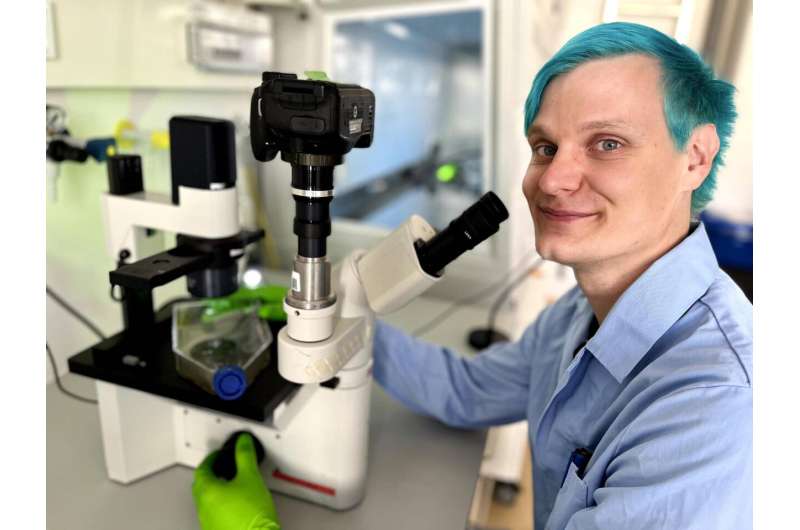Bacteria provide immunity against giant viruses

Amoebae receive surprising support in defense against viruses: The bacteria they are infected with prevent them from being destroyed by giant viruses. A research team led by microbiologist Matthias Horn from the Center for Microbiology and Environmental Systems Science at the University of Vienna have investigated how a virus infection proceeds when the amoebae are simultaneously infected with chlamydia.
The research team shows for the first time that intracellular bacteria known as symbionts protect their host against viruses. Amoebae are protists, single-celled microorganisms with a cell nucleus. Protists play a key role in food webs and ecosystem processes. Consequently, the results of the study suggest that the interaction between symbionts and viruses influence the flow of nutrients in ecosystems. The study is now published in the journal PNAS.
Intracellular bacteria: Friend not foe?
Under natural conditions, protists including the studied amoebae are often infected by bacterial symbionts, which include chlamydiae. Chlamydiae are primarily known as human pathogens. However, close relatives of these pathogenic chlamydiae have been discovered in a variety of animals and protists.
"Since, according to current knowledge, chlamydial infection leads to a slower growth rate of the infected host, chlamydiae are commonly considered to be parasitic," explains Patrick Arthofer, first author of the study and Ph.D. student at the Center for Microbiology and Environmental Systems Science (CMESS).
Parasitic bacteria have a negative effect on the host while symbionts with a positive effect are called mutualists. "Our study shows that chlamydiae are actually mutualists rather than parasites here, since they protect the protists against lethal infections by giant viruses. After all, slower growth is better than dying," says Arthofer.

Giant viruses and their unicellular hosts
Infections with bacteria, but also those with viruses, shape how populations of protists develop. The researchers from the University of Vienna and the Université de Poitiers in France wanted to know how a viral infection proceeds when protists are simultaneously infected with bacteria. In order to study a situation that might also occur in natural environments, the scientists first isolated amoebae, bacteria, and a giant virus from the same environmental sample.
Giant viruses have only been known for about 20 years. Their discovery challenges many previously held assumptions about viruses, for they are not only multiple times larger than all previously known viruses, but also possess genes that were previously thought to be characteristic of cellular organisms such as bacteria, animals, plants and fungi. According to current knowledge, they are completely harmless to animals and humans. Their natural hosts are single-celled organisms with a cell nucleus, the protists.
When giant viruses infect a host cell, they remodel the entire host cell and set up a so-called "virus factory." This viral factory produces hundreds of new virus particles until the host cell bursts and releases the new viruses. "If the protist is infected with bacterial symbionts, this very process is blocked," explains Matthias Horn, head of the research group at the University of Vienna. "Our study shows that the presence of the chlamydia does not prevent the virus from being taken up. However, the viruses subsequently cannot form a functional virus factory," he says.
The interaction of the bacteria with the giant viruses inside the amoeba does not only have consequences for the host itself. "A common hypothesis is that these intracellular interactions between giant viruses and bacterial symbionts have played a role in giant viruses becoming so complex," Horn says. The study of virus-symbiont interactions could therefore provide answers to the question of how giant viruses evolved.

Bacteria that protect against viruses influence food webs
Protists are widespread—living in waters, seawater and seabeds, among other places. They feed on bacteria, thus absorbing the nutrients bound in the bacteria and, when being eaten themselves, pass them on to animals such as small crustaceans. By this means only, the animals have access to the nutrients provided by bacteria. If the protists are killed by viruses, the nutrients released can only be metabolized once again by bacteria.
"If chlamydiae protect the protists from being destroyed by viruses, they are not merely ensuring that their hosts remain a source of food for small animals. Beyond that, the bacterial symbionts could influence the entire nutrient cycle in ecosystems," explains Arthofer.
Future research will show to what extent this process affects the functioning of ecosystems. "In general, a closer look at virus-symbiont interactions tells us something about ecosystem dynamics," says Matthias Horn. In a next step, the scientists therefore want to investigate the exact mechanism behind the bacteria-mediated protection of protists from giant viruses.
Additionally, Anouk Willemsen, co-author of the paper and virologist at CMESS, is focusing specifically on giant viruses: In a research project recently approved by the European Research Council (ERC), she is investigating how giant viruses have acquired their complexity.
More information: Defensive symbiosis against giant viruses in amoebae., Proceedings of the National Academy of Sciences (2022). DOI: 10.1073/pnas.2205856119
Journal information: Proceedings of the National Academy of Sciences
Provided by University of Vienna





















